Abstract
Coandă effect screen structures are used to protect hydropower turbines in mountainous regions from impurities of different sizes. To save time during the design phase, computational fluid dynamics simulations (CFD) can support experimental investigations. Experimental investigations and 2D CFD simulations are performed on the base of the Coandă effect screen structure. Flow rates of 7 m3/h, 8 m3/h, and 9 m3/h are simulated, captured by a camera system in the experiments, and compared. In the experimental setting, the fill level of the Coandă rake is measured. For comparison, the RMSE of the y-position fill level is computed between simulation and measurement. Furthermore, the mass flow balance, , is evaluated. The RMSE of the y-direction fill level between simulation and measurement is on average 2.1 mm and 4.4 mm for the lower CFD level and the higher CFD level, respectively. Experiments show an average 6.72% higher Π. The reason for this is that 2D CFD does not consider the surface tension of the borders. In the diverted flow region, the flow field based on experiments appears less viscous than in the simulations. CFD simulations are an appropriate tool to support the design process of Coandă effect screens, especially for fill level determination. The validated CFD code can reduce the cost and time of experiments to design future Coandă effect screen structures.
1. Introduction
While turbines and generators of hydroelectric power plants are already highly developed [1], water capture in general, or the “rakes” for separating the bedload and purifying the useful water, represents the greatest weakness, especially in mountainous regions [2]. Whereas simple technologies for water catchment (e.g., horizontal rakes or filters) are sufficient for calm watercourses with constant flow rates and little bedload material, which also only have small to medium sizes, the requirements in alpine environments are much more complex [3,4,5]. There, the available water quantity and the quantity and size structure of the bedload are highly variable and cover an enormous range [6]. In addition, the effects of local extreme weather events such as heavy precipitation, hail, or storms are felt very quickly. Therefore, the filtering or purification of the water plays a central role in the collection of service water in the alpine region in order not to damage the turbine wheel [7] of the hydroelectric power plants. The Coandă effect is named after the Romanian scientist Henri Marie Coandă [8]. When a liquid or gas flows along a solid surface, it tends to stick to the surface. Due to fluid flow viscosity, a velocity boundary layer is formed at the wall. Based on the Bernoulli equation [9], a higher velocity results in a smaller static pressure. A pressure gradient is responsible for the fact that the flow is redirected. This effect is, for example, used to separate solids from a fluid flow in order to use the flow within hydroelectric power plants. A device for that is the so-called Coandă effect screen (CES) structure, see Figure 1. Water with solids flows to the weir edge, over the acceleration plate, and to the screen, where the solids are separated. The screen consists of struts with a usually triangular profile that are transverse to the direction of the flow. Each strut is mounted at a small angle with respect to the flow. The separation effect is based on the distance between the struts and the screen continuously overflowing [10]. The CES structure is self-cleaning and provides reliable operation with minimum maintenance [11]. It has been successfully applied several times in hydroelectric power plants and has been constantly optimized [12,13,14]. Furthermore, experiments showed that CES performed well in cold climates, in spite of some periods of reduced intake capacity [15].
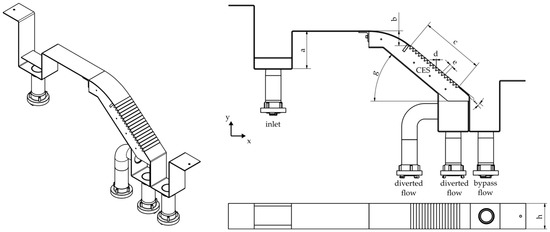
Figure 1.
Experimental setup of the CES. For simplicity, the borders are not shown, see Figure 2. At the inlet, the flow rates for the three different experiments (7 m3h−1, 8 m3h−1, and 9 m3h−1) are set and controlled with a PI controller. Diverted and bypass flows are reused at the inlet. a = 147 mm, b = 58 mm, c = 246.32 mm, d = 0.93 mm, e = 13.70 mm, f = 5°, g = 40°, h = 100 mm.
In [16], a theoretically based computational model was developed to predict the hydraulic performance. Model predictions were compared based on results from nearly 100 clean water laboratory tests with several different prototype-size screen structures. This model allows designers to estimate the screen capacity and economical screen structures for a variety of objectives and in situ conditions. The combination of experimental investigations and computational fluid dynamics (CFD) can further support the design process and evaluate the flow capacity of the CES [17]. Hosseini and Coonrod [18] investigated fluid flow conditions based on a physical and numerical approach. The open-source numerical modeling tool Delft3D-FLOW, Deltares (NL), was used to observe the flow velocity vector field, the water depth, and the Froude number in a diversion structure with Coandă effect screens. The main weakness is the very coarse grid (mesh) used for the spatial discretization in the numerical analysis, without consideration of the fluid flow boundary layer with a refined mesh towards the walls. Furthermore, the flow through the Coandă effect screen was not investigated. In [19], 2D CFD simulations of the Coandă effect screen were quantitatively compared with experiments. Compared to [18], a much better grid was used for the numerical simulation, but still no boundary layers were introduced to simulate the velocity gradient towards the wall with a high accuracy. Furthermore, the outlet boundary condition of the diverted flow was close to the rake and defined for every slot with a pressure boundary condition (ambient pressure), which might not be physically correct. Due to viscosity, the flow field is affected at the position where the boundary condition is set. The results showed that the flow rate differences between simulations and experiments were smaller than 5%. In another research paper [20], 216 sets of experimental data were used to develop empirical equations to predict the water capture performance and sediment release efficiency for Coandă-type intakes using artificial intelligence methods. Initially, dimensionless parameters were created and subsequently analyzed by a multicollinearity analysis. Next, nonlinear equations were formulated using the genetic algorithm approach to determine the exponents and coefficients. The equations were then calibrated with 70% of the data and validated with the remaining 30%. The validation outcomes indicated that the empirical equations exhibited low values of mean absolute error and RMSE, along with high R2 values, for both the water capturing performance and the sediment release efficiency. The results showed that the geometric parameters of the intake were comparatively more sensitive than the flow characteristics.
The presented study deals with mesh weaknesses and similar boundary conditions. There are already existing approaches for using artificial intelligence to design CES. The focus of the study is not only to compare the flow rate, but also to generate a sophisticated image fill level comparison between simulation and experiments by thresholding and Canny edge detection filtering. The CES is experimentally investigated and 2D-simulated by CFD in Ansys Fluent. The fill level results are compared to find the metric of the accuracy of CFD simulations to support the design process with all underlying performance parameters. The validated CFD code should reduce the cost and time of the experiments to design future Coandă effect screen structures.
2. Materials and Methods
2.1. Experimental Setup
Figure 1 shows the experimental setup with a laboratory-scale CES provided by Stocker Technik. The CES is designed with 17 triangular cross-section-shaped elements, each tilted by an angle of f = 5° and with a side length of e = 13.7 mm. The CES is set up at an angle of g = 40° with respect to the horizontal. An acceleration plate with a height of 58 mm is designed before the first rake element. The slot width between every CES element is d = 0.93 mm and the width is h = 100 mm. Every single element of the CES separates the flow into a bypass flow and a diverted flow region. Both are pumped back to the inlet by a centrifugal pump (Sewabloc F 50-215G H 132S, KSB, Frankenthal, Germany), which provides the desired flow rates of 7 m3h−1, 8 m3h−1, and 9 m3h−1 for each experiment. At the inlet, there is a baffle plate and a reservoir with a height of a = 147 mm to homogenize the flow and provide stationary boundary conditions, which would not be created by the pump alone due to its transient flow behavior. The inlet volume flow rate is PI controlled [21] with an inductive flow measurement device (Promag W, ENDRESS + HAUSER, Reinach, Switzerland). The PI controller is designed to avoid control errors in the stationary boundary conditions. For the experimental analysis, the bypass volume flow rate was manually measured with an external reservoir with a volume of 100 L and a stopwatch. All investigations were performed at 20 °C, with νair = 1.7894 × 10−5 kg m−1s−1, ρair = 1.225 kg m−3, in water, with νwater = 0.001 kg m−1s−1 and ρwater = 998.2 kg m−3. There are no solid particles involved. Gravity g = −9.81 ms−2 is in the y-direction (see Figure 1).
The temporal averaged bypass flow rate of 8 min is evaluated and quantitatively compared to the simulations for each of the three experiments. To evaluate the fill level, a camera (Basler Ace 2412-30 us, Basler, Ahrensburg, Germany) with a lens (Basler C11-1620 1.1″, f = 16 mm, Basler Germany) is used. A coarse reference grid with a spacing of 1 mm for the small grid and 5 mm for the extended grid is inserted at the bottom border of the CES. The lens is focused on the thorn, see Figure 2. In total, three pictures are captured: (a) with the mm-grid, (b) without the mm-grid, and (c) with a thorn that shows the remaining water in the middle of the rake. Each picture has a resolution of 4096 × 3000 pixels with a 96 dpi vertical and a 96 dpi horizontal resolution. The camera data were saved in TIFF file format and were not compressed. Furthermore, the fill level was measured with a caliper at every rake element.

Figure 2.
Photos of the experimental setup as an example at 7 m3/h. The lens is focused on the thorn. (a) With a mm grid; (b) without a mm grid; (c) with a thorn to show the remaining water on the middle of the rake. The results for 8 m3/h and 9 m3/h are not shown.
2.2. Numerical Setup
Two-dimensional fluid flow simulations were performed in Ansys® Workbench 2021 R2, ANSYS, Inc. (Canonsburg, PA, USA), with the software packages DesignModeler, Meshing, and Fluent . The 3D CAD model of the CES was loaded in STP file format and converted to a 2D cross-section by the “Surfaces From Faces” command. Two simplified geometries, see Figure 3a, were designed, one with the boundary conditions of the presented experimental setup and the second one as it was applied in [19], see Figure 3a, magenta. At the inlet, a Dirichlet boundary condition [22] defines the desired flow rates of 7 m3h−1, 8 m3h−1, and 9 m3h−1, respectively. The inlet was elongated by 800 mm to provide a fully developed flow profile at the CES. This was created since it is not possible to insert the baffle plate in the 2D simulation in an appropriate way. The 800 mm elongation space was initialized with water to save computational time. All other boundary conditions are summarized in Figure 3a. All outlet boundary conditions were set to a constant pressure of 1013.25 mbar. Subsequently, an unstructured CFD mesh, consisting of quads with 4 nodes and triangles with 3 nodes (linear elements), was generated with 17 cells at the critical Coandă rake flow cross-section and five boundary cells, characterized by a smooth transition and a growth rate of 1.2 orthogonal to the wall boundary. The first cell of the boundary layer was set to 0.022 mm to model the viscous flow appropriately [22]. The resolution outside the boundary layer at the CES is set to 0.125 mm. Therefore, the functions “face sizing” and “inflation” within Ansys Meshing were used. In the “face sizing” function, the meshing behavior was set to soft to allow minor variation in the element size to improve the mesh quality. The final mesh had 589 272 nodes and 579,946 elements, with a maximum skewness of 0.86 and a maximum aspect ratio of 10.1. The mesh is shown in Figure 3b. To simulate the two-phase (water and air) flow, the Volume of Fluid (VoF) model was used with default parameters. The flow Reynolds number (Re) [23] at the inlet is around 34,000. Compared to the critical Re of pipe flow (2300 [23]), the flow is turbulent, and therefore the default Fluent turbulence model k-ω SST was used, in the same way it was applied in [19]. Gravity, g = −9.81 ms−2, was defined in the y-direction (see Figure 3a). The flow field was initialized at v = 0 ms−1. The field was initialized with the standard initialization. With the numerical solution process, a stationary solution was found. Simulations were performed with second-order accuracy. Table 1 shows the numerical schemes and solution methods.
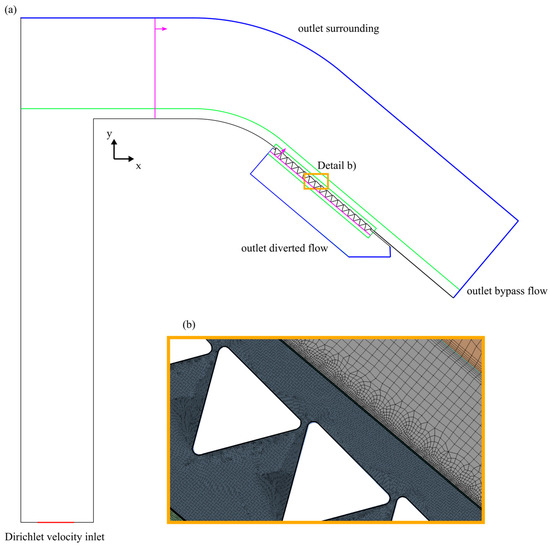
Figure 3.
(a) 2D simplified geometry for the CFD simulation. Types of boundary conditions are shown in different colors. Red: Dirichlet velocity inlet, black: walls, green: defined interfaces for different cell resolutions, blue: pressure outlet. Detail (b) shows the mesh resolution at CES. The magenta lines show simplified boundary conditions as proposed in [19]. Number of nodes: 589,272. Number of elements: 579,946.

Table 1.
Numerical schemes and solution methods [24].
For the simulation, the scaled residuals for all conservation equations converged to the threshold < 1 × 10−4 (continuity < 1 × 10−4, x-velocity < 5 × 10−7, y-velocity < 5 × 10−7, k < 6 × 10−5, omega < 3 × 10−5, and vof < 4 × 10−6). For comparison with the experiment, the relative water mass flow rate (see Figure 1) was evaluated. Furthermore, a mesh convergence study based on [25] with simplified boundary conditions (see Figure 3a, magenta lines) and 9 m3h−1 was performed. Therefore, two additional meshes with half and a quarter of the spatial resolution (constant refinement ratio r = 2) were generated. In this method, the CFD simulation results must be reduced to a single scalar quantity, f. Therefore, the diverted mass flow rate was chosen.
2.3. Postprocessing of the CFD Results
To compare the CFD results with the measurement results, the fill level was evaluated, see Figure 4a. Therefore, the CFD simulation results are converted to an 8-bit (0–255) greyscale image, see Figure 4b. Thresholding with half of the bit range (128–255), see Figure 4c, splits the simulation results into three regions: water, water–air, and air. Subsequently, the Canny edge detection filter [26] (Gaussian kernel radius: default 2.0, low threshold: 2.5, high threshold: 7.5) was applied to detect the edges, see Figure 4d. Edges that are not relevant to the fill level were removed. The figure was changed from an 8-bit grayscale image to an RGB image again. The two edges were labeled as red and green. All operations were performed with ImageJ 1.53r software (Bethesda, MD, USA). The origin of the figure is at the 8th rake, which is also used as the origin of the experiments.
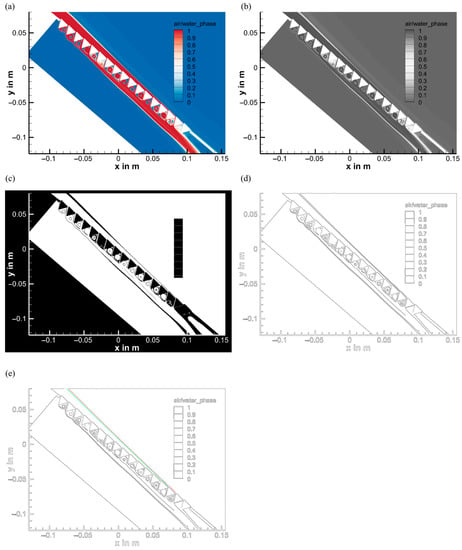
Figure 4.
Postprocessing of the CFD results: (a) original image, (b) 8-bit grayscale, (c) thresholded range 128–255, (d) Canny edge detection filter; (e) lower and upper fill levels are marked as green and red, respectively. The figure series is generated as an example based on the results of 7 m3h−1. The results for 8 m3h−1 and 9 m3h−1 and the results of the simplified boundary conditions (see Figure 7) are not shown.
Images were digitized in WebPlotDigitizer 4.2 software (Automeris; San Francisco, CA, USA). Pixel-based image data were converted to numerical x,y coordinates. The raw data were thresholded by 8-bit RGB color to an upper level (246, 0, 0) of ±10 and a lower level (0, 246, 0) of ±10. A discretization window of 1 pixel was chosen. The picture resolution is 1920 × 1707 pixels. More than 350 x,y points for each edge were saved in CSV file format. For statistical evaluation, simulated coordinates were resampled to the experimental coordinates.
2.4. Postprocessing of the Experimental Results
For this study, it is necessary that the experimental investigations are in the same position as the simulated results. A coordinate system was inserted at the 8th rake in the downstream direction of the CES, see Figure 5a, horizontal and vertical white lines. Ten centimeters in the x-direction and in the seven centimeters in the y-direction were taken from the mm grid for calibration. The calibration picture and the pictures of the experimental results are exactly in the same position. The pixel coordinates were taken (see Figure 2a) and applied to the corresponding Figure 2b,c. The mm grid was set parallel to the camera pixels in the experiment. The coordinate system was inserted by line macros in ImageJ, see Figure 5a. Subsequently, the threshold color filter (hue: 0–255, saturation: 88–255, brightness: 0–255, method: yen, threshold color: red, color space: HSB, dark background) is applied, see Figure 5b. The Canny edge detection filter (Gaussian kernel radius: 1.0, low threshold: 2.5, high threshold: 7.5) detected the edges in the images, see Figure 5c. The lower fill level is marked in green and the upper fill level is marked in red, see Figure 5d.
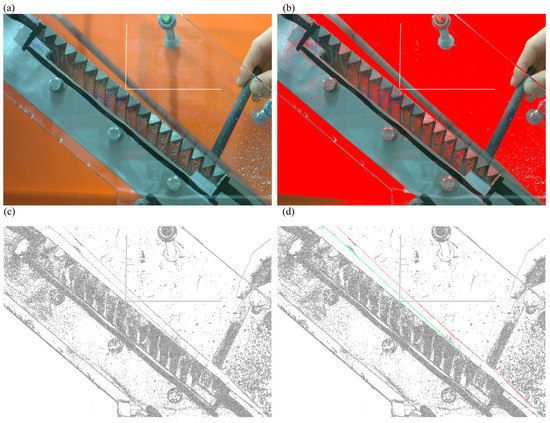
Figure 5.
Postprocessing of the experimental results. (a) Original image with coordinate system x = 10 cm and y = 7 cm, (b) threshold color filter (hue: 0–255, saturation: 88–255, brightness: 0–255, method: yen, threshold color: red, color space: HSB, dark background), (c) thresholded range 128–255, (d) Canny edge detection filter (Gaussian kernel radius: 1.0, low threshold: 2.5, high threshold: 7.5). The figure series was generated as an example based on the results of 7 m3h−1. The results for 8 m3h−1 and 9 m3h−1 and the results of the simplified boundary conditions (see Figure 7) are not shown.
Images were digitized in WebPlotDigitizer 4.2 software (Automeris; San Francisco, CA, USA). Pixel-based image data were converted to numerical x,y coordinates. The raw data were thresholded by 8-bit RGB color for an upper level (246, 0, 0) of ±10 and a lower level (0, 246, 0) of ±10.
2.5. Statistical Evaluation
The root mean square error (RMSE) of the y-coordinate between simulation and measurement at the edges for the three flow rates 7 m3h−1, 8 m3h−1, and 9 m3h−1 was investigated.
3. Results
Figure 6 shows a qualitative comparison of the simulation and experimental results for flow rates of 7 m3h−1, 8 m3h−1, and 9 m3h−1. The simulation results are at the final (fifth) time step of the transient simulation. The experiments show a snapshot of the moment in time when the flow is developed. For a quantitative comparison, Π is evaluated for the experiments as well as for the simulations, see Table 2. Both show similar rake behavior, i.e., remaining water in the middle of the rake. The thorn shows that at 7 m3h−1, there is no water at the 16th rake in the middle of the CES; at 8 m3h−1, there is water at the 17th rake; and at a flow rate of 9 m3h−1, water is even at the last rake in the middle of the CES. The same behavior is also visible in the three 2D-CFD simulations. A different flow regime is depicted in the diverted flow region. The CFD simulations overestimate the Coandă effect, which is illustrated by the fact that the water remains at the rake and does not fall in the negative y-direction. A different flow regime shows the experiment in the diverted flow region. The water falls and does not connect the rakes. The simulation results with simplified boundary conditions are shown in Figure 7. In the diverted flow region, the simulation shows similar flow behavior as in the experiment, whereas from a physical point of view, the conditions are not correct since the flow is close to the boundary and the viscous effects could not be simulated accurately.
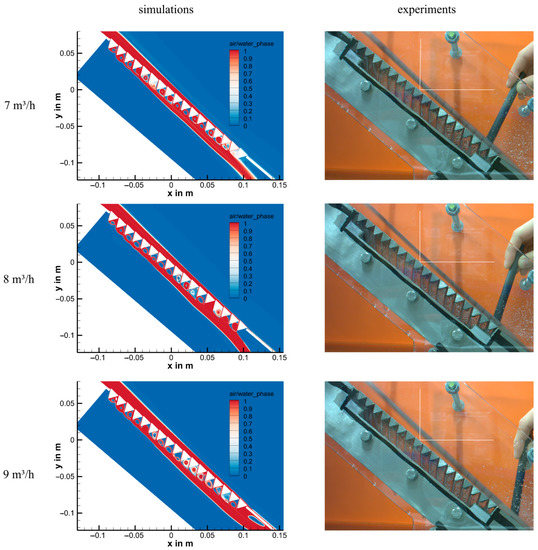
Figure 6.
Left column: VoF CFD simulation results. The geometry and boundary conditions are shown in Figure 2. Red: water and blue: air. Right column: experimental results. The white lines show the coordinate system (x = 10 cm and y = 7 cm). The origin is set at the 8th rake. The thorn shows the empty water fill level in the middle of the rake. The simulation results with simplified boundary conditions are not shown (see Figure 7).

Table 2.
Relative bypass flow comparison between simulations and measurements.
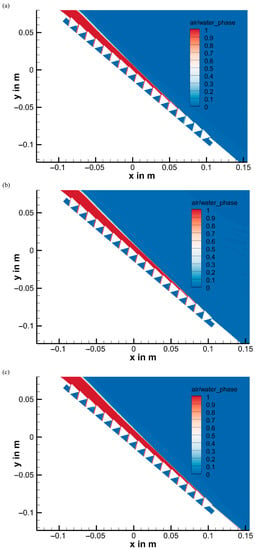
Figure 7.
VoF 2D CFD simulation results. Boundary conditions are proposed in [19]. (a) 7 m3h−1, (b) 8 m3h−1, (c) 9 m3h−1.
Figure 8 shows the extracted lines for the experiment (black), the CFD lower fill level (magenta, Figure 6), and the CFD upper fill level (green) for the flow rates of (a) 7 m3/h, (b) 8 m3/h, and (c) 9 m3/h. The dashed lines show the simulation results with simplified boundary conditions. For visualization purposes, the geometry of the rakes is inserted as a point cloud. The outcome of the statistical analysis shows good agreement between the simulation results and the experimental results. As an example, the RMSE between simulation and experiment for 7 m3/h is 2.19 mm, see Table 3. The lower fill level of the CFD simulations fits better with the experiments than the upper fill level. The root mean square error of the y-coordinate between simulation and measurement at the edges for the three flow rates 7 m3/h, 8 m3/h, and 9 m3/h is investigated.
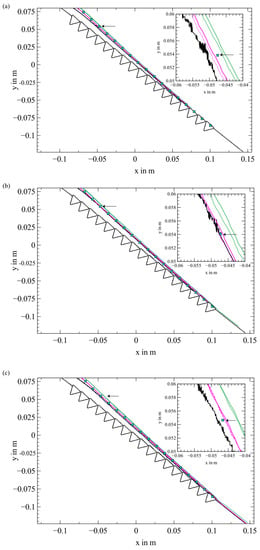
Figure 8.
Plots showing the extracted edges for the experiment (black line), the CFD lower fill level (magenta), and the upper fill level (green) at (a) 7 m3h−1, (b) 8 m3h−1, and (c) 9 m3h−1. Furthermore, the rake geometry is inserted for easier understanding. The cross symbols show the fill level measured with the caliper. The subfigures in (a–c) zoom in on specific parts of the plots to see the difference between measurement, simulation, and simulation with simplified boundary conditions. Dashed lines show simulation results with simplified boundary conditions, as suggested in [19].

Table 3.
RMSE calculation of simulated and measured edges of the flow level height. SBC: simplified boundary condition.
The simulation results of the mesh independence study show a diverted mass flow rate , , and , where is the mesh with the weakest spatial resolution and is the mesh with the best spatial resolution. This results in an order of convergence of p = 3.80 and an extrapolated for theoretical 0 mm spatial resolution of . The grid convergence factor gcf = 0.998, which is close to 1, is ensured and mesh independence is ensured.
4. Discussion
In this work, an experimentally compared CFD code to optimize CES is presented. This forms the basis for reducing the experimental effort in designing CES with CFD. Compared to [17], quantitative (Table 2 and Table 3) and qualitative comparisons (Figure 6 and Figure 7) between CFD multiphase simulations and the corresponding experiments are presented. This work is an extension of [19], in which the outlet boundary conditions at the diverted flow region were set very close to the Coandă rake elements. Therefore, it is questionable whether these assumptions are sufficient. In the presented paper, these assumptions are taken away from the Coandă rake elements to make the boundary conditions more realistic from a physical point of view. Furthermore, CFD results with the same procedure as [19], i.e., simplified boundary conditions, are generated. The results show that is less accurate with the simplified boundary conditions and the fill level is more accurate with the simplified boundary conditions compared to the newly generated results. The reason is that with simplified boundary conditions, the flow is not predicted accurately at the last three rakes (15th, 16th, and 17th rakes) compared to the experiment. In contrast, the fill level RMSE (see Figure 8 and Table 3) is improved with respect to the experiment with simplified boundary conditions. At the diverted flow region, it could be shown that the CFD results are accurate with simplified boundary conditions, which means the results could be confirmed with those in [19]. In the new CFD results presented, an unrealistic flow behavior at the diverted flow region is simulated. The reasons might be because in CFD simulations with RANS modeling, smaller eddies than the mesh are not simulated but wrongly modeled with virtual viscosity. Since the Coandă effect is a complex physical effect, RANS turbulence modeling does not work with the Coandă rake elements. The state-of-the-art turbulence model RANS k-ω-SST was used. Additionally, other RANS turbulence models (k-ϵ and Spalart–Allmaras) and models without any turbulence were tested but not presented in this paper. The results with k-ω-SST were chosen to be presented since the results for the fill level and the mass flow rate fit the experiments best. k-ω-SST features advantages over the k-ω model in calculating the velocity boundary layer and the k- model in calculating the free stream flow with a higher accuracy [27]. Unfortunately, the computational resources for this were not available. The simulations and measurements do not consider solid impurities. This simplification was introduced to decrease the complexity of CFD. In the simulations, the volume of fluid model shows a region where both water and air are present (see Figure 6, white region). In contrast, in the experiments, such a region was hard to identify with a camera system. Therefore, two simulation datasets were compared with one experimental dataset. Compared to the already existing CFD simulations of CES, a higher spatial resolution and/or additional boundary layers were used [17,18,19]. Therefore, it is not surprising that the presented CFD simulation results are independent of the spatial resolution. Regarding the mesh independence study, two additional simulations with less spatial resolution were performed since the spatial resolution of the “base” simulation was already better than that presented in other studies.
5. Conclusions
The experimentally determined flow level above the screen is reproduced very well by the simulations for all three inflow volume flows. The validated CFD code can reduce the cost and time of experiments to design future Coandă effect screen structures. However, the surface tension effects [28] at the borders of the Coandă rake change the overall flow rate. This effect cannot be considered in the 2D CFD simulations. The next steps are to perform 3D simulations to obtain a better insight into the flow with the RANS turbulence abstraction level or more sophisticated CFD with large eddy simulations (LES) or direct numerical simulations (DNS). However, all techniques will need much more computational resources. For investigations with this a high Reynolds number, even supercomputers would take a long time and utilize a large amount of hard disk space.
As a result, there is no flow stall in the downward flow, as in the test rig, but the water is deflected laterally at the lower edge of the triangular profile.
Author Contributions
Conceptualization, T.S., M.P. and M.B.; methodology, T.S., S.K., M.B. and M.P.; software, M.B., T.S., M.S. and S.K.; validation, T.S., M.S., S.K. and M.P.; formal analysis, T.S., M.S. and S.K.; investigation, M.S., T.S. and M.B.; resources, T.S., M.P. and M.B.; data curation, M.S. and S.K.; writing—original draft preparation, M.B. and T.S.; writing—review and editing, T.S., M.B., M.S., S.K. and M.P.; visualization, M.B. and T.S.; supervision, M.P., S.K. and M.S.; project administration, T.S. and M.P.; funding acquisition, T.S. All authors have read and agreed to the published version of the manuscript.
Funding
The present study was supported by the provincial government of Tyrol, Austria (Tiroler Landesregierung) as a part of the project “FHCS—Flexible Hydro Catchment System” (ref. no. F.31933/13-2021).
Institutional Review Board Statement
Not applicable.
Informed Consent Statement
Not applicable.
Data Availability Statement
Data sharing not applicable.
Acknowledgments
We thank Arthur De Jaegher for improving the English language.
Conflicts of Interest
The authors declare no conflict of interest.
References
- Zhang, Z. Pelton Turbines; Springer International Publishing: Berlin/Heidelberg, Germany, 2016. [Google Scholar]
- Aigner, J.; Kreisler, A.; Rindler, R.; Hauer, C.; Habersack, H. Bedload pulses in a hydropower affected alpine gravel bed river. Geomorphology 2017, 291, 116–127. [Google Scholar] [CrossRef]
- Rai, A.K.; Kumar, A.; Staubli, T. Hydro-abrasive erosion in Pelton buckets: Classification and field study. Wear 2017, 392–393, 8–20. [Google Scholar] [CrossRef]
- Bajracharya, T.R.; Acharya, B.; Joshi, C.B.; Saini, R.P.; Dahlhaug, O.G. Sand erosion of Pelton turbine nozzles and buckets: A case study of Chilime Hydropower Plant. Wear 2008, 264, 177–184. [Google Scholar] [CrossRef]
- Morales, A.M.; Pachón, I.F.; Loboguerrero, J.; Medina, J.A.; Escobar, J.A. Development of a test rig to evaluate abrasive wear on Pelton turbine nozzles. A case study of Chivor Hydropower. Wear 2017, 372–373, 208–215. [Google Scholar] [CrossRef]
- Comiti, F.; Mao, L.; Penna, D.; Dell’Agnese, A.; Engel, M.; Rathburn, S.; Cavalli, M. Glacier melt runoff controls bedload transport in Alpine catchments. Earth Planet. Sci. Lett. 2019, 520, 77–86. [Google Scholar] [CrossRef]
- Felix, D.; Albayrak, I.; Boes, R.M. Schwebstoffmonitoring und Verschleiss an Peltonturbinen am Fallbeispiel Fieschertal: Vorbereitende Laborversuche zu Partikelmessmethoden, Wasser-Energie Glob. denken-lokal Handel. In Proceedings of the Wasserbausympo-sium 2012, Graz, Austria, 12–15 September 2012; pp. 117–124. [Google Scholar]
- Reba, I. Applications of the Coanda effect. Sci. Am. 1966, 214, 84–93. [Google Scholar] [CrossRef]
- Lasiecka, I.; Triggiane, R. Exact controllability of the Euler-Bernoulli equation with boundary controls for displacement and moment. J. Math. Anal. Appl. 1990, 146, 1–33. [Google Scholar] [CrossRef]
- Witek, M.; Lifa, I. Optimierung der Coanda-Rechen für Schweizer Gewässer, Wasserbau-Symposium 2021. In Wasserbau in Zeiten von Energiewende, Gewässerschutz und Klimawandel. Band 1; Eigenverlag der Versuchsanstalt für Wasserbau, Hydrologie und Glaziologie (VAW), ETH Zürich: Zurich, Switzerland, 2021; pp. 119–126. [Google Scholar]
- Strong, J.J.; Ott, R.F. Intake screens for small hydro plants. Hydro Rev. 1988, 7, 66–69. [Google Scholar]
- Wahl, T.L. Design Guidance for Coanda-Effect Screens; US Department of the Interior, Bureau of Reclamation: Washington, DC, USA, 2003.
- Wahl, T.L. Improving Coanda-Effect Screen Technology; United States Bureau of Reclamation: Denver, CO, USA, 2017.
- May, D. Sediment Exclusion From Water Systems Using a Coanda Effect Device. Int. J. Hydraul. Eng. 2015, 4, 23–30. [Google Scholar]
- Nøvik, H.; Lia, L.; Opaker, H. Performance of Coanda-Effect Screens in a Cold Climate. J. Cold Reg. Eng. 2014, 28, 04014006. [Google Scholar] [CrossRef]
- Wahl, T.L. Hydraulic Performance of Coanda-Effect Screens. J. Hydraul. Eng. 2001, 127, 480–488. [Google Scholar] [CrossRef]
- Dzafo, H.; Dzaferovic, E. Numerical Simulation of Air-Water Two Phase Flow Over Coanda-Effect Screen Structure. In Advanced Technologies, Systems, and Applications; Springer International Publishing: Berlin/Heidelberg, Germany, 2017; pp. 249–255. [Google Scholar]
- Hosseini, S.M.; Coonrod, J. Coupling numerical and physical modeling for analysis of flow in a diversion structure with Coanda-effect screens. Water 2011, 3, 764–786. [Google Scholar] [CrossRef]
- Carrión-Coronel, E.; Ortiz, P.; Nanía, L. Physical Experimentation and 2D-CFD Parametric Study of Flow through Trans-verse Bottom Racks. Water 2022, 14, 955. [Google Scholar] [CrossRef]
- Hazar, O.; Tayfur, G.; Elçi, S.; Sigh, V.P. Developing Predictive Equations for Water Capturing Performance and Sediment Release Efficiency for Coanda Intakes Using Artificial Intelligence Methods. Water 2022, 14, 972. [Google Scholar] [CrossRef]
- Ogata, K. Modern Control Engineering; Prentice Hall: Hoboken, NJ, USA, 2010. [Google Scholar]
- Ferziger, J.H.; Peric, M. Computational Methods for Fluid Dynamics; Springer Science & Business Media: Berlin/Heidelberg, Germany, 2012. [Google Scholar]
- Landau, L.D.; Lifshitz, J.M. Fluid Mechanics—Third Revised English Edition; Academic Press: Pergamon, Turkey, 1959. [Google Scholar]
- Fluent, A.N.S.Y.S. Fluent 14.0 User’s Guide; Ansys Fluent Inc.: Canonsburg, PA, USA, 2020. [Google Scholar]
- Baker, N.; Kelly, G.; O’Sullivan, P.D. A grid convergence index study of mesh style effect on the accuracy of the numerical results for an indoor airflow profile. Int. J. Vent. 2020, 19, 300–314. [Google Scholar] [CrossRef]
- Canny, J. A Computational Approach to Edge Detection. IEEE Trans. Pattern Anal. Mach. Intell. 1986, PAMI-8, 679–698. [Google Scholar] [CrossRef]
- Menter, F.R. Two-equation eddy-viscosity turbulence models for engineering applications. AIAA J. 1994, 32, 1598–1605. [Google Scholar] [CrossRef]
- Wahl, T.L.; Shupe, C.C.; Dzafo, H.; Dzaferovic, E. Surface Tension Effects on 360 Discharge Capacity of Coanda-Effect Screens. J. Hydraul. Eng. 2021, 147, 04021026. [Google Scholar] [CrossRef]
Disclaimer/Publisher’s Note: The statements, opinions and data contained in all publications are solely those of the individual author(s) and contributor(s) and not of MDPI and/or the editor(s). MDPI and/or the editor(s) disclaim responsibility for any injury to people or property resulting from any ideas, methods, instructions or products referred to in the content. |
© 2023 by the authors. Licensee MDPI, Basel, Switzerland. This article is an open access article distributed under the terms and conditions of the Creative Commons Attribution (CC BY) license (https://creativecommons.org/licenses/by/4.0/).